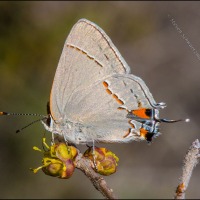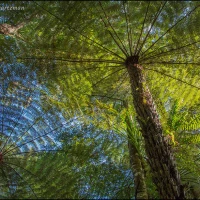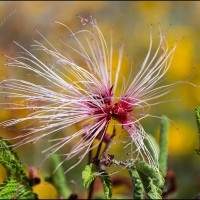Evangeline Beach
On the cool (maybe 50°F) and overcast afternoon of June 6th, after visiting Nova Scotia’s Grand-Pré National Historic Site, with its exhibit about Longfellow’s “Evangeline,” Evangeline and I stopped briefly at nearby Evangeline Beach.
Notice the distant greenery in the first picture. Because our visit came at or near low tide, I was able to walk out for a closer look at those plants, which are underwater twice each day.
In addition to the lone rock in the second picture, some of the broad rock strata closer in to the shore caught my attention as well.
© 2018 Steven Schwartzman














this looks like an amazing landscape. i’ve never visited nova scotia but it certainly is somewhere i’d love to visit.
ksbeth
July 24, 2018 at 5:30 AM
Even without seeing many pictures of Nova Scotia, I felt it was high time to visit the place. Go there if you can.
Steve Schwartzman
July 24, 2018 at 7:57 AM
These are the photos I’ve been waiting for. In imagination, the vast, empty flats are easy to fill with the events that took place there, and a sense of desolation still lingers: strong enough for your images to capture it and bring tears to my eyes.
When I see your travel photos, I often think, “That’s a beautiful spot. I’d love to go there.” When I looked at these, I thought, “I have to go there.”
shoreacres
July 24, 2018 at 6:33 AM
What a different reaction. Then go there when you can, and if it’s desolation you crave, you might try fall (winter probably being an overdose).
Bob Dylan wrote “Desolation Row.” I wondered if Leonard Cohen, Canadian that he was, wrote anything about Evangeline; a search turned up nothing. Can we resurrect him to write that song?
Steve Schwartzman
July 24, 2018 at 8:18 AM
It’s not that I crave desolation — only that seeing the place brought back the events. As for songs, this is one that captures the story beautifully. I enjoyed seeing the last photo in the video: the Evangeline statue in St. Martinville.
shoreacres
July 24, 2018 at 10:19 AM
What a great song! It reminds me of Leonard Cohen’s “Song of Bernadette.”
I saw from a comment that a certain Michel Conte wrote “Évangéline” so I searched for more information about him. The French Wikipedia article has plenty of information, the one in English practically none. The French article notes that not long before his death from a heart attack in 2008, he said in an interview that people in Quebec didn’t even know about the existence of Acadia: “I was the first person to speak about Acadia, and no one will ever be able to take that away from me.”
In addition to the St. Martinville statue you singled out at the end of the video, there was an earlier shot of the Evangeline statue we saw in front of the church in Grand-Pré.
Steve Schwartzman
July 24, 2018 at 10:51 AM
Looks like a wonderful stretch for a squelchy walk, popping the bladderwracks (and ain’t that a fun word!) and I love looking into tidal pools. It must have been very hard for the Acadians to be deported from this place.
Robert Parker
July 24, 2018 at 8:06 AM
The seaweed that featured here two posts back was identified to me as probably being Fucus vesiculosus, the same species called bladderwrack in the Oxford Dictionaries online.
Speaking of squelchy, at the next place we visited along the Bay of Fundy that day, I stepped in a place on the beach where I thought the ground firmer than it was. My right foot sank into tidal mud, and that was the end of those shoes. Oh well, they were old shoes and after serving me well for several years had already begun to come apart at the seams.
What a difference, though, between abandoning a pair of shoes and abandoning one’s homeland, as the Acadians were forced to do.
Steve Schwartzman
July 24, 2018 at 8:37 AM
It’s a terrible thing, to be driven out of your home. Haven’t read much about it, but I know they died in droves. Some of them were relocated to Maryland, where at least there were some coreligionists, even if the Toleration Act was long gone by then.
Robert Parker
July 24, 2018 at 9:08 AM
A couple of decades ago we visited the so-called Evangeline Trail in the part of Louisiana where some of the Acadians settled:
https://www.lafayettetravel.com/explore/legend-of-evangeline/
Louisiana was still a French colony, so it made sense for people who spoke French in North America to go there. The Acadians in Louisiana became the Cajuns (compare the way Indian got pronounced Injun).
I had to look up the Toleration Act:
https://www.britannica.com/event/Toleration-Act-Great-Britain-1689
Steve Schwartzman
July 24, 2018 at 9:20 AM
That’s something, Steven, which I like at the German North Sea Coast so much: when the sea retreats at ebbtide and all those different shapes and colours of the land appear.
Pit
July 24, 2018 at 8:44 AM
Then I’m pleased to have brought back memories of the North Sea for you. The Bay of Fundy offers extreme examples of disappearing and reappearing land. From what you say about the coast you remember, you’d enjoy experiencing Nova Scotia. Too bad for both of us that it’s so far from Texas.
Steve Schwartzman
July 24, 2018 at 8:53 AM
Isn’t the Bay of Fundy one of the places on Earth, if not THE place, with the highest tides? And yes, there are so many far-away places one wants to see.
Pit
July 24, 2018 at 9:07 AM
You’re correct that the greatest change in tides anywhere in the world occurs along the Bay of Fundy:
https://portraitsofwildflowers.wordpress.com/2018/07/02/the-bay-of-fundy/
Steve Schwartzman
July 24, 2018 at 9:13 AM
Thanks for the link. 🙂
Pit
July 24, 2018 at 9:15 AM
You’re welcome. I expect to do two more posts showing other parts of the coast along the Bay of Fundy.
Steve Schwartzman
July 24, 2018 at 9:24 AM
🙂 Looking forward to those.
Pit
July 24, 2018 at 9:57 AM
Sure thing. There may even be three.
Steve Schwartzman
July 24, 2018 at 10:06 AM
This is beautiful. No wonder I’ve heard of so many things about how beautiful this country is, and your images sure show it.
Maria
July 24, 2018 at 1:42 PM
I don’t know why it took me so long to get up there. Better late than never, right? Perhaps you’ll be inspired to make your way up there one of these days.
Steve Schwartzman
July 24, 2018 at 2:38 PM
Yesterday I saw Audubon’s documentary in PBS, which I hadn’t seen, and they mentioned he traveled through Nova Scotia, Newfoundland, and even further north of Canada to document the birds there.
Maria
July 24, 2018 at 4:35 PM
I watched that PBS documentary about Audubon a few years ago. Before then I knew almost nothing about him. In museums I’ve seen a few of his full-size works. Thanks for the reminder that he also worked in Canada.
Steve Schwartzman
July 24, 2018 at 5:42 PM
Ok
Maria
July 24, 2018 at 5:45 PM
The song Évangéline which Linda mentioned in her comment is a perfect accompaniment to your photos. Sad though the Acadian story is, I am happy that you and your Evangeline were able to enjoy this beautiful place.
Gallivanta
July 26, 2018 at 9:33 AM
I’m grateful to her for pointing out that wonderful (if sad) song. How did I not know about it? I don’t remember ever hearing about the songwriter, Michel Conte, either.
Steve Schwartzman
July 26, 2018 at 10:22 AM
Interestingly (to me anyway) is that I only learned about Évangéline a few years ago. Maybe my grandmother who knew a lot of poetry would have been familiar with Longfellow’s Evangeline but the only Longfellow poem I heard spoken or talked about for most of my childhood/youth was The Song of Hiawatha.
Gallivanta
July 26, 2018 at 7:05 PM
After the Spanish-American war the United States took over the Philippines, and one of the first things the American government did there was to greatly expand public education, modeled on the American system, of course. As a result, the Evangeline that you’ve met in person grew up knowing Longfellow’s poem. Longfellow was the best-known American poet of the 1800s and into the 1900s, which is why your grandmother would have known his poetry. It’s why you knew “The Song of Hiawatha.” Coincident with the great social upheavals of the 1960s, Longfellow quickly fell out of favor and out of the American school curriculum—along with arithmetic, history, grammar, civics, etc.
Steve Schwartzman
July 26, 2018 at 10:12 PM
And that educational purging could perhaps be considered as epic a tragedy as Evangeline.
Gallivanta
July 26, 2018 at 10:46 PM
True, alas!
Steve Schwartzman
July 27, 2018 at 5:42 AM
The color contrasts are striking, Steve.
tanjabrittonwriter
July 26, 2018 at 9:19 PM
Yes, it’s almost all browns and blues, with those bits of green thrown in. The overcast probably worked in my favor as a photographer.
Steve Schwartzman
July 26, 2018 at 10:15 PM
Hey Steve .. such an interesting landscape. And that greenery 🙂! Wonderful photos ..
Julie@frogpondfarm
July 28, 2018 at 6:29 PM
You’ve got some great coasts over there in NZ, too. I feel fortunate to have been both places.
Steve Schwartzman
July 28, 2018 at 9:26 PM
[…] to Blomidon Provincial Park, which had been indistinctly visible across Minas Bay from Evangeline Beach. Occasionally there’d be a break in the clouds and a shaft of light would briefly light up […]
Blomidon Provincial Park | Portraits of Wildflowers
August 6, 2018 at 4:57 AM